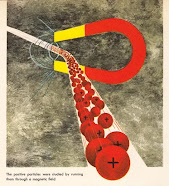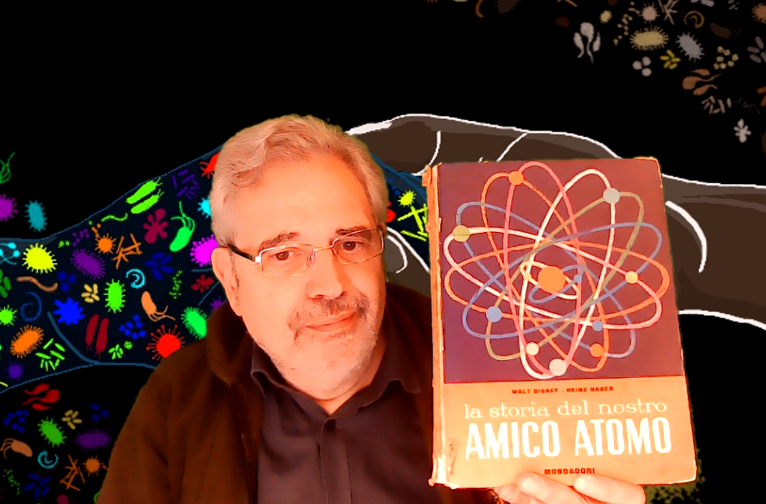The Italian translation of Walt Disney’s book, “Our Friend, the Atom,” originally published in 1956. It was a powerful pitch of the nuclear industry to sell a completely new energy system to the world. It could have been a turning point for humankind, but it didn’t work: nuclear energy was abandoned in the 1960s-1970s. It was probably unavoidable: too many factors were staked against the nuclear industry. But we may wonder about what could have happened if it had been decided to pursue nuclear energy and abandon fossil energy. (In the background: a completely different concept, that of “holobionts,”)
 I remember having read Walt Disney’s book, “Our Friend, the Atom,” (1957) in the 1960s when I was, maybe, 10 years old. That book left a powerful impression on me. Still today, when I visualize protons and electrons in my mind, I see them in the colors they were represented in the book: protons are red, electrons are blue or green. And I think that one of the reasons why I decided to study chemistry at the university was because of the fascinating images of the atomic structure I had seen in the book.
I remember having read Walt Disney’s book, “Our Friend, the Atom,” (1957) in the 1960s when I was, maybe, 10 years old. That book left a powerful impression on me. Still today, when I visualize protons and electrons in my mind, I see them in the colors they were represented in the book: protons are red, electrons are blue or green. And I think that one of the reasons why I decided to study chemistry at the university was because of the fascinating images of the atomic structure I had seen in the book.
More than 60 years after its publication, “Our Friend the Atom” remains a milestone in the history of nuclear energy. You can easily find on the Web the Disneyland TV episode from which the book was derived. It is still stunning today, as it was in the 1950s, in terms of imagery and sheer mastery of the art of presentation. The nuclear industry was in rapid expansion and it saw itself as able to grow more. Hence, a pitch for the “Atomic Age” that would have brought cheap and abundant energy for everyone, perhaps even energy that was “too cheap to meter.”
It didn’t work. You see in the figure the number of new reactors installed worldwide. It peaked around 1970 — that means that plans to build new reactors declined earlier than that. Already in the 1960s, the enthusiasm for nuclear energy was declining. It was a decline that would last until now, despite some recent signs of a possible restart. (image from Univ. Texas)
What went wrong? Today, the whole story is usually dismissed as the result of the machinations of those evil Greens who had opposed nuclear energy for ideological reasons. Yet, the popular “smiling sun” campaign didn’t become widespread before the late 1970s, when the nuclear industry was already in free fall. Never in their history have the Greens been able to stop an industrial field that was making money. Why should they have been so successful with the nuclear industry? (by the way, with a campaign that started at least a decade after that the intended target had begun its decline. Those evil Greens even had time machines!)
Reviewing this old story, we see that the smiling sun campaign was not the cause but a symptom of the troubles that the nuclear industry was facing. Up until the 1950s, it had been an almost exclusively military industry. The production of electric power for the civilian market was a side task that brought some extra revenue, just like the production of isotopes for research and for medical applications. But, by far, the main product of the industry was nuclear warheads. And that was the problem: these warheads were being stockpiled in absurd numbers, well beyond the reasonable needs (if we want to use that term) of national defense.
The problem must have been clear already in the 1950s just by looking at the growth trends of the number of warheads. It was clear that the industry was saturating its market. The only solution to stimulate the demand was to start an actual nuclear war but, fortunately, not everyone agreed on that idea.
But where to find new markets for the nuclear industry? With already so many nuclear weapons around, a possible solution was to move into the civilian market. In the 1950s, the US engaged in a program that started with the speech by President Eisenhower known as “Atoms for Peace” in 1953. The idea was to disseminate nuclear technology all over the world in order to produce energy and other useful products. Walt Disney’s 1956 movie was an offshoot of this program.
Seen in retrospective, the “Atoms for Peace” program couldn’t possibly have worked, and it didn’t. The nuclear industry faced a series of hurdles, each one sufficient to stop its growth, alone. All together, they were truly too much. Here is a list.
1. A mineral resource problem. In the 1950s, it was already known (*) that the mineral reserves of fissile uranium, the 235 isotope, were insufficient for nuclear plants to take over the task of energy production worldwide. That could have been possible only by means of the new and scarcely tested technology of “breeding.” A few attempts were made to build commercial breeding reactors, but they were victims of the general rule that everything always costs more and takes more time. Gradually, the funds needed to keep developing the technology dried out and the efforts stopped. The best known of these reactors, the French “Superphenix” was closed in 1996. No breeders, no atomic age.
2. A pollution problem. In the 1950s, nuclear waste was not seen as a major problem, but it was also clear that a substantial increase in the number of nuclear reactors would have created the necessity of doing something with the radioactive waste. And it started to be understood that dismantling the old nuclear reactors after the end of their life was a long and expensive task. Theoretically, these were solvable problems, but at huge costs, and who was going to pay? The question was never answered at that time and it remains unanswered today.
3. A commercial problem. Electrical energy from nuclear reactors always remained more expensive than the energy produced by gas or coal. So, the production of energy for the civilian market needed to be subsidized to be competitive. Up to 1977, subsidies were provided indirectly by the military industry with the purchase of the plutonium produced by the reactors, used to make nuclear warheads. These subsidies were abolished by President Carter in part because the US had already too many warheads, and in part to avoid the proliferation of fissile material. At this point, the industry was not any more competitive and who would invest money in a non-competitive industry?
4. A competition problem. In the 1960s, the concept of “hydrogen economy” started becoming popular. It seemed to be a good idea for the nuclear industry to claim that they could produce not only electric power, but also a fuel that could power vehicles. Unsurprisingly, that put the nuclear industry in direct competition with the fossil fuel industry. We know that everyone tends to defend their turf when it is threatened and we can’t imagine that the fossil industry would supinely accept to be superseded. By the late 1970s, an aggressive public relations campaign based on the “smiling sun” symbol had turned nuclear power into everyone’s bugaboo. Probably we will never know who financed that campaign, but we know who benefited from it.
5. A strategic problem. The idea of “atoms for peace” was complete nonsense in strategic terms. Up to the 1960s, the USSR and the US had a nearly complete monopoly of nuclear weapons. With the atoms for peace program, the US found itself in an impossible strategic quandary: how to stop nuclear proliferation while at the same time disseminating nuclear technologies all over the world? The solution was to quietly forget about atoms for peace while aggressively stopping the construction of nuclear reactors everywhere and especially in countries believed to be strategically unreliable. In 1981, the “Tammuz” reactor under construction in Iraq, near Baghdad, was destroyed by the Israeli air force. In 1987, a referendum against nuclear energy was held in Italy, a country believed to be at risk as an ally of the US because of the presence of a large Communist Party. The referendum forced the Italian government to dismantle four already built reactors and never to engage again in nuclear energy production. Iran continued the nuclear program that had been started with the “atoms for peace” program, but it was sabotaged at every step. From the 1980s onward, it became clear that not only nuclear weapons but also nuclear energy was something that belonged only to a selected club.
You see that, as usual, when something must happen, you cannot stop it from happening. That the nuclear industry was to fail was written on the wall of the reactors because of a series of factual circumstances, surely not because a bunch of long-haired Greens were protesting in the streets. Yet, it is not impossible to think that history could have followed a different path.
Imagine that the US military leaders had stomped their feet on the ground and said, “we are going to have breeders in America.” Imagine that sufficient funds could have been funneled into the task. Finally, imagine that the technological problems of breeders could have been solved. At that point, the US and the whole Western World could have switched to a largely nuclearized energy system, possibly including a hydrogen-powered transportation system. It is unlikely that China and the Soviet Union would not have followed along the same path. And it would have been difficult to stop nuclear technology from diffusing in other regions of the world.
What kind of world would that be, today? Theoretically, we would have abundant energy for everyone or, at least, for those countries that had embarked on the nuclearization of their economies. And this energy could be produced without emitting greenhouse gases into the atmosphere, so that Earth’s climate would not have been affected, at least not directly.
But we would have faced a completely different range of problems. Had the nuclearization plan been carried out, the amount of fissile material available in the world would have been multiplied by one or two orders of magnitude and it is almost unthinkable that it would stay out of the hands of the many petty tyrants, fanatical religious leaders, and assorted psychopaths who tend to crave that kind of thing. Consider also that nuclear plants (especially breeders) offer a delicious target for military and terrorist attacks, and you may imagine what kind of problems we could have today. The “nuclear winter” scenario, proposed in the 1990s, was demonized, but never really debunked. And that without mentioning the possibility of the mismanagement of the nuclear wastes and the fact that plutonium is the most poisonous substance known to humans.
Consider also another problem, much bigger, that lurks unrecognized in the shadows for this scenario. In the 1950s, Marion King Hubbert was working on oil depletion and in 1956 he proposed his famous “bell shaped” production curve, later known as “peak oil.” Hubbert also proposed that nuclear energy would replace fossil fuels. But note in the figure below how, in his view, nuclear energy would not have prevented “peak oil” from taking place at about the same time that was foreseen without nuclear energy. Hubbert understood very well that the enormous effort needed to build the new nuclear infrastructure would have had to be based on fossil fuels, and so would not have reduced their production.
Now, note something in the image: whereas fossil fuels follow a bell-shaped production curve, nuclear energy reaches a plateau and remains there for thousands of years. Why?
Hubbert must have been well aware that the “thousands of years of supply” that the nuclear industry often claimed for the mineral reserves of uranium to be turned into plutonium were possible only if production were not to increase over a certain rate. But what would have stopped people from increasing energy production even more? You think that people would have been thinking, “now we have enough” and then spend their time relaxing and forgetting about economic growth? One world: pyramids.
Why wouldn’t Plutonium, being a finite mineral resource, not follow a “bell-shaped” curve, peaking and starting to decline afterward? (Want to mention thorium? Sure, but it is another finite resource, it doesn’t change the concept). So, it would grow, peak, and then decline.
It is impossible to calculate when “peak plutonium” could take place in a fully nuclearized world. It would depend on many factors, the available resources, the efficiency of the breeding technology, the energy return on investment, the cost of waste management, and more. In a previous post, I made some very rough estimates: if the plutonium-based economy were to be run on the known laws of the economy, it is hard to imagine that the reserves of fissionable materials would last for more than a few centuries, possibly even less than a century. (Fusion? Sure, let’s wait 50 more years and….).
And here we stand. Playing the “what if” game is a lot of fun, but we should remember that we are talking about the dream expressed by Walt Disney’s “Our friend, the Atom,” A dream that, likely, had the same chances to turn into reality as others proposed by Walt Disney, such as for a poor country girl to marry a prince. And it is not at all guaranteed that the country girl would have a happy marriage!
We don’t know if a plutonium-based economy ever was something more than a dream. Today, it is too late to turn back to a moment in history that is past and gone, although it is not impossible that someone will want to try to resurrect a dream that could easily turn into a nightmare.
What we know is that, as always, we stand at the intersection of past and future, in that fleeting moment we call “present.” From now on, infinite possibilities branch out. Those leading to a peaceful and prosperous future are few, maybe there are none. But we must plod on. It is a journey that will lead us somewhere, even though we can’t say where.
_________________________________________________________________
(*) The story of the assessment of the uranium reserves is fascinating in itself. Palmer Putnam published in 1953 the book “Energy in the Future” where he carried out one of the first quantitative assessments of the potential of fission energy in terms of mineral reserves of uranium See below the relevant paragraph
Note the key words: “assuming breeding.” That is, the assumption is that energy can be extracted from both isotopes of uranium, the 235 and the 238. The result is 1700 Quads, or about 100 times the energy content of the (then) known oil and gas reserves.
You understand why in the 1950s it became obvious that breeding plutonium was absolutely necessary for a nuclear-based economy. If only U235 were to be “burned,” then the resource would be suddenly reduced to 0.72% of the total, that is to 12 Quads. Assuming an optimistic 30% efficiency (but, really, way too optimistic), the total obtainable would be 4 Quads. Earlier on, Putnam had established that the world would require more than 70 Q of energy by the year 2000. No breeding, no atomic age. Simple.










